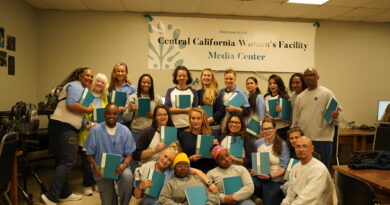Ice behind bars: CCWF’s ‘hottest’ commodity

On any given 110°F day at Central California Women’s Facility (of which there are many), you’ll hear spoken amongst the population: “Hey, let me get some of that, let me buy a bag, what you want for it?”
The sun is beaming. The air is hot. Sweat is dripping from the brows of those encountering the blazing heat. Shirts cling to the bodies enduring the summer’s glare, as onlookers watch from their windows, glad not to be a part of yet another one of Chowchilla’s heat waves.
Some of “that” is ice — as in frozen water. It’s a hot commodity here at CCWF. It’s so hot because it’s not something that the population can easily attain, unless you’re a kitchen or yard crew worker. It’s so cold that on the black market, it ranges anywhere from a dollar a cup to ten dollars a bag, depending on the size.
Frozen water is expensive. But to the majority of the population, it’s like drugs to a fiend. And to those that are addicted, buying ice is an everyday occurrence. That means giving up hygiene items, bags of chips, candy, etc. just to suppress their cravings for the day.
You may wonder if this is only during the hot summers’ heat. Not quite so. Even during the dead of winter, the craving for ice is ever so prevalent. While the rest of the population is wrapped up in scarves, gloves, and beanies trying to stay warm, drinking hot cocoa, tea or coffee, the ice fiends are crunching away at their ever-so-cold ice.
While some speculate that they crave ice due to a vitamin deficiency, others just downright enjoy the cold feel of an ice cube in their mouth, the hard crunch of that ice between their teeth, and the cold sensation of that frozen water going down their throat.
“I’ve loved ice since I was a little kid,” CCWF resident Destiny Trotter, one of the many ice fiends within the institution, said. “I used to be scared to crush the ice between my teeth, but now I crave the crunch of ice. It’s like I have an ice fetish. The sound of the ice crushing between my teeth just does it for me.”
“Work change” is a very small but busy section of the prison, one located on each facility yard, wherein people are processed through for work, medical or other miscellaneous appointments, and school.
A corrections officer (CO) works inside this security check, making sure people are being processed in a timely manner to and fro. That officer ensures that a person clears the metal detector. They search every bag, and if an incarcerated person doesn’t clear the detector they are often patted down or stripped searched. These searches are to make sure that the population is not bringing contraband through work change.
Sounds serious, right? There are signs on the doors of work change that read: “Do not bring ice through.” If ice is caught, whether it’s in a bag or cup, the officer will give you a direct order to throw it out.
Because ice is not allowed, the population will often have to sneak it through, sometimes putting a bag of ice in their pants, even when it’s 50°F cold on top of cold. That bag of ice is deemed an essential need to that incarcerated person. It’s against the rules to bring liquids though work change too.
Having ice in your possession is not the thing that actually leads to trouble. It’s not following a direct order from a corrections officer. Being told to throw the ice out of your cup, or throw away the bag of ice and not complying is where the trouble comes in.
When asking the population, no one seems to know why ice is taboo, especially on a 110°F day. Corrections officers seem perplexed too as to why ice has never been allowed through work change. Several of them speculate that while ice isn’t technically contraband, they don’t allow it because it’s being taken from one place to the other and possibly being sold. Another CO stated that she never knew why ice wasn’t allowed through work change, but it had been like that since she’s been working here.
Why is ice such a big deal—it’s just frozen water right? Well, here in CCWF it is a big deal to both the population and the COs, of course for very different reasons. On one hand, it’s a must-have for the population. But on the other, it may be an opportunity to exercise some form of control.
Part of the reason may be that ice machines aren’t available to the population, they never have been. Though every officers’ station in the facility housing units has a mini- ice machine, the incarcerated population aren’t afforded those same opportunities.



